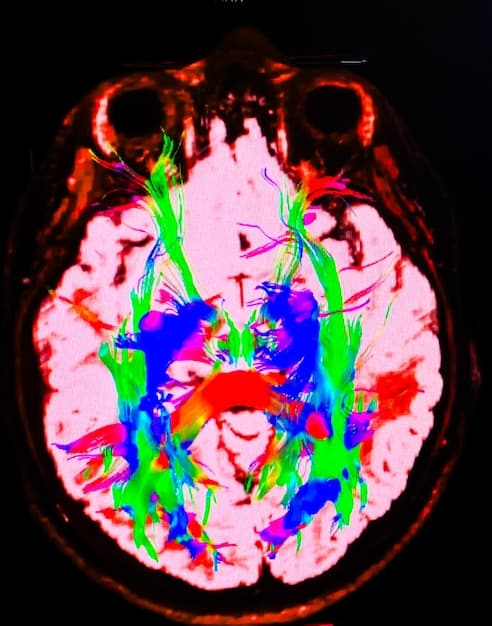Cerebral Palsy Research: Breakthroughs in Treatments & Therapies

Recent advancements in cerebral palsy research are paving the way for innovative treatments and therapies, offering new hope for improved motor skills, reduced complications, and enhanced quality of life for affected individuals.
The Latest Research on Cerebral Palsy: New Treatments and Therapies on the Horizon is bringing renewed optimism for managing this complex condition. Scientific breakthroughs and innovative approaches offer the potential to significantly improve the lives of individuals with cerebral palsy.
Understanding Cerebral Palsy: Recent Findings
Cerebral palsy (CP) affects millions worldwide, and ongoing research is critical to improving outcomes. Recent studies have shed light on the underlying causes, potential prevention strategies, and the effectiveness of various interventions.
Understanding the complexities of CP, including its different types and presentations, is crucial for tailoring effective treatment plans. Research continues to refine our understanding of the brain’s role and the impact of early interventions.
Genetic Factors in Cerebral Palsy
While cerebral palsy is often associated with birth injuries or complications, recent research highlights the role of genetics in some cases. Identifying genetic markers may lead to earlier diagnosis and targeted therapies.
The Importance of Early Diagnosis
Early diagnosis of cerebral palsy is crucial for initiating timely interventions. Studies show that early intervention can significantly improve motor skills, cognitive development, and overall quality of life.
- Genetic testing may offer earlier detection in some cases.
- Advanced neuroimaging techniques can aid in early diagnosis.
- Early intervention programs demonstrate significant benefits.
Advancements in understanding the etiology and early indicators of cerebral palsy are crucial for improving outcomes and enabling timely interventions.

Innovative Therapeutic Approaches
Traditional therapies for cerebral palsy, such as physical and occupational therapy, remain essential. However, innovative approaches are emerging, offering new avenues for improving motor function, reducing spasticity, and enhancing independence.
These novel therapies often incorporate technology, such as robotics and virtual reality, to create engaging and effective treatment experiences. They also emphasize intensive, task-specific training to maximize functional outcomes.
Robotic-Assisted Therapy
Robotic-assisted therapy uses advanced robotic devices to support and guide movement. This approach can help individuals with CP improve strength, coordination, and range of motion.
Virtual Reality Interventions
Virtual reality (VR) offers immersive and interactive environments for therapy. VR interventions can improve motor skills, balance, and cognitive function in individuals with CP.
- Robotic exoskeletons provide support for weakened limbs.
- VR simulations create engaging therapy scenarios.
- Task-specific training maximizes functional gains.
These innovative therapeutic approaches hold great promise for enhancing motor function and improving the overall quality of life for individuals with cerebral palsy.
Advances in Medication and Surgical Interventions
Medication and surgical interventions play a significant role in managing specific symptoms associated with cerebral palsy, such as spasticity, pain, and orthopedic deformities. Recent advances in these areas offer improved outcomes and reduced side effects.
New medications are being developed to target specific neurotransmitters involved in spasticity. Minimally invasive surgical techniques are also gaining popularity, offering less pain and faster recovery times.
Selective Dorsal Rhizotomy (SDR)
Selective dorsal rhizotomy (SDR) is a surgical procedure that reduces spasticity by selectively cutting nerve fibers in the spinal cord. Advances in SDR techniques have improved outcomes and reduced complications.
Intrathecal Baclofen Therapy
Intrathecal baclofen (ITB) therapy involves delivering baclofen, a muscle relaxant, directly to the spinal cord. ITB therapy can effectively reduce spasticity and improve function in individuals with CP.
- New medications target specific neurotransmitters to reduce spasticity.
- Minimally invasive surgical techniques offer less pain and faster recovery.
- Rehabilitation is crucial after surgical interventions to maximize benefits.
These advances in medication and surgical interventions provide valuable options for managing specific symptoms and improving the overall well-being of individuals with cerebral palsy.

The Role of Technology in Rehabilitation
Technology is transforming the field of cerebral palsy rehabilitation. Assistive devices, communication aids, and telehealth platforms are empowering individuals with CP and enhancing access to care.
These technological advancements are expanding the possibilities for independence, communication, and participation in daily activities. They are also enabling remote monitoring and personalized therapy programs.
Assistive Technology Devices
Assistive technology devices, such as adaptive switches, wheelchairs, and communication aids, can significantly improve independence and quality of life for individuals with CP.
Telehealth and Remote Monitoring
Telehealth platforms enable remote consultations, therapy sessions, and monitoring of individuals with CP. This approach improves access to care, especially for those in rural areas or with mobility limitations.
- Adaptive devices enhance independence and participation.
- Communication aids facilitate effective communication.
- Telehealth platforms improve access to specialized care.
Technology is playing an increasingly important role in empowering individuals with cerebral palsy and expanding access to rehabilitation services.
Nutritional Considerations and Management
Proper nutrition is crucial for individuals with cerebral palsy, who may face challenges with feeding, swallowing, and digestion. Nutritional interventions can improve growth, bone health, and overall well-being.
Registered dietitians can provide individualized nutritional assessments and recommendations to address specific needs and challenges. They can also educate caregivers on strategies to optimize nutrition and prevent complications.
Addressing Feeding and Swallowing Difficulties
Feeding and swallowing difficulties are common in individuals with CP. Strategies such as modifying food textures, using adaptive feeding equipment, and providing oral motor therapy can improve feeding safety and efficiency.
Optimizing Bone Health
Individuals with CP are at increased risk of osteoporosis and fractures. Ensuring adequate calcium and vitamin D intake, along with weight-bearing exercises, can help optimize bone health.
- Nutritional assessments identify specific needs and challenges.
- Modified food textures and adaptive equipment improve feeding safety.
- Adequate calcium and vitamin D intake optimize bone health.
Nutritional considerations and management are essential components of comprehensive care for individuals with cerebral palsy.
The Importance of Family-Centered Care
Cerebral palsy affects not only the individual but also their family. Family-centered care approaches recognize the importance of supporting families and empowering them to actively participate in their child’s care.
Family-centered care involves collaboration between healthcare professionals, families, and individuals with CP to develop individualized treatment plans that address the unique needs and priorities of the family.
Parent Education and Support Groups
Parent education programs provide families with information about CP, treatment options, and strategies for managing challenges. Support groups offer a sense of community and shared experience.
Promoting Family Well-being
Recognizing and addressing the emotional, social, and financial needs of families is crucial for promoting their well-being and ability to provide optimal care for their child with CP.
- Family-centered care empowers families to actively participate.
- Parent education programs provide valuable information and support.
- Addressing family needs promotes overall well-being.
Family-centered care is essential for providing comprehensive and compassionate care for individuals with cerebral palsy and their families.
Future Directions in Cerebral Palsy Research
Research on cerebral palsy continues to evolve, with promising new avenues being explored. These include advanced neuroimaging techniques, regenerative medicine approaches, and personalized therapies.
These future directions hold the potential to further improve diagnosis, treatment, and long-term outcomes for individuals with CP. Continued research efforts are crucial for advancing our understanding of this complex condition.
Advanced Neuroimaging Techniques
Advanced neuroimaging techniques, such as diffusion tensor imaging (DTI) and functional MRI (fMRI), provide detailed insights into brain structure and function in individuals with CP.
Regenerative Medicine Approaches
Regenerative medicine approaches, such as stem cell therapy, aim to repair damaged brain tissue and improve motor function in individuals with CP. While still in early stages, these approaches hold significant promise.
- Advanced neuroimaging techniques provide detailed brain insights.
- Regenerative medicine approaches aim to repair damaged brain tissue.
- Personalized therapies tailor treatment to individual needs.
Future research directions offer hope for further advancements in the diagnosis, treatment, and long-term outcomes for individuals with cerebral palsy.
| Key Point | Brief Description |
|---|---|
| 💡 Early Diagnosis | Crucial for timely interventions and improved outcomes. |
| 🤖 Robotic Therapy | Improves strength, coordination, and range of motion. |
| 💊 Medication Advances | Target specific symptoms like spasticity with fewer side effects. |
| 👪 Family Support | Essential for well-being and active participation in care. |
FAQ
▼
Recent research emphasizes the potential role of genetic factors in some cases of cerebral palsy, which could lead to earlier and more targeted diagnostic approaches.
▼
Robotic therapy utilizes advanced devices to support movement, assisting in enhancing motor skills like strength and coordination, and increasing the range of motion.
▼
Early diagnosis is crucial because it allows for the prompt implementation of interventions, significantly improving motor skills, cognitive abilities, and the person’s overall quality of life.
▼
Family-centered care, involving support groups and education, ensures families are active participants in care, leading to better outcomes and a higher quality of life for all involved parties.
▼
Recent advancements focus on medications that target specific neurotransmitters to alleviate spasticity with fewer side effects, therefore enhancing management of cerebral palsy’s physical symptoms.
Conclusion
The ongoing research into cerebral palsy is bringing about exciting and hopeful advancements in treatment and therapy. From genetic understanding and robotic-assisted therapies to improved medications and family-centered care, the future holds great promise for enhancing the lives of individuals affected by CP. Continued dedication to research and innovation will undoubtedly lead to even more significant breakthroughs in the years to come.





